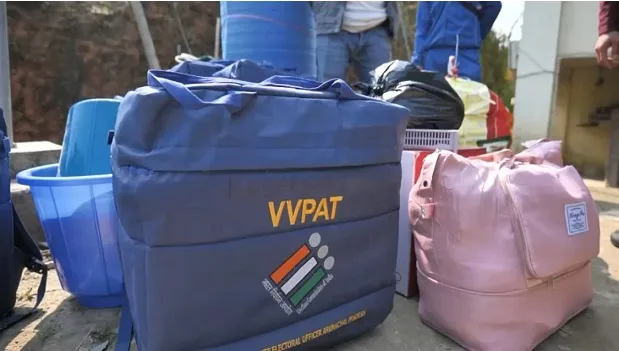The Supreme Court bench hearing the petition on VVPAT-EVM vote cross-verification told the Election Commission that they need to explain the steps taken to maintain the ‘sanctity’ of the electoral process. “Let nobody have apprehension that something which is expected is not being done,” the bench of Justice Sanjiv Khanna and Justice Dipankar Datta said.
‘Everything can’t be suspected,’ observes SC

AMN / WEB DESK New Delhi
The Supreme Court on Thursday reserved its verdict on a clutch of petitions demanding 100% cross-verification of votes cast on EVMs with Voter Verified Paper Audit Trails (VVPATs). A plea was filed by NGO Association for Democratic Reforms (ADR) seeking cross verification of votes cast by voters as ‘counted as recorded’ in the EVM with the VVPAT.
“Everything can’t be suspected,” the Supreme Court on Thursday told petitioners seeking a 100% cross-verification of votes cast through EVMs with Voter Verifiable Paper Audit Trail (VVPAT)
“Now you’re going too far. Everything can’t be suspected. You can’t be critical of everything…please also appreciate if they have done something good. We heard you because we are also concerned,” a Bench of Justice Khanna and Justice Dipankar Datta told advocate Prashant Bhushan who represented petitioner Association for Democratic Rights (ADR).
VVPAT is an independent vote verification system which enables an elector to see whether his vote has been cast correctly. It generates a paper slip which can be viewed by the voter. It is kept in a sealed cover and can be opened in case of a dispute.
The petitioners — ADR and others — have demanded a 100 percent count of VVPAT slips as opposed to the current practice of verification of only five randomly-selected EVMs per assembly segment through VVPAT paper slips. They have sought measures to ensure that votes are “recorded as cast” and “counted as recorded”.
They have also sought reversal of the EC’s 2017 decision to replace the transparent glass on VVPAT machines with an opaque glass through which a voter can see the slip only when the light is on for seven seconds.
On Thursday, Bhushan said as the first phase of polling in the 2024 Lok Sabha elections was just a day away, the easiest thing for the poll panel to do was to let the light in the VVPAT screen remain lit throughout the voting time — as opposed to seven seconds allowed in the present system — so that the voter could see the slip cutting and falling.
Citing some media reports, Bhushan alleged that an EVM showed an extra vote during a mock poll in Kerala’s Kasaragod. However, the EC termed the said reports as “false”.
“These news reports are false. We have verified the allegation from the district collector and it appears that they are false. We will submit a detailed report to the court,” senior Deputy Election Commissioner Nitesh Kumar Vyas told the Bench.
On behalf of the Election Commission, senior counsel Manindar Singh defended the process followed by it for conducting elections through EVMs.
The EC asserted that it has matched EVM votes with more than four crore VVPAT slips and no mismatch has been found so far.
However, senior counsel Sankaranarayanan objected to the EC’s claim, saying “Their own document shows that there is a mismatch … There is at least one instance of mismatch. Let’s not say there is no mismatch.”
In his short intervention, Solicitor General Tushar Mehta said, “This happens periodically on the eve of elections. It has an impact on voter turnout, harms democracy. They are making the choice of voters into a joke. I have told everyone on my side that … be ready for some planted article/news article for tomorrow.”
The Bench – which posed several questions to the Election Commission regarding the whole electoral process involving the EVM and VVPAT, said, “This is an electoral process and there needs to be sanctity to it and let there be no doubt about it.”
A senior official of the Election Commission explained the entire process to the Bench. He said the Ballot Unit, Control Unit and VVPAT together constituted the EVM and all three units were stored after the election in Strong Rooms which were sealed in the presence of candidates/their agents.
Noting that VVPAT was only a printer, he sought to emphasize that no tampering was possible in EVMs at any stage as no software was involved in the loading of symbols in VVPAT. At every stage representatives of political parties were present, he added.
He said about 17 lakh VVPAT machines were there and the manufacturer didn’t know which machine was going to which constituency and which button had been allocated to which party.
